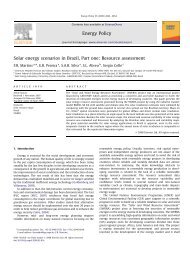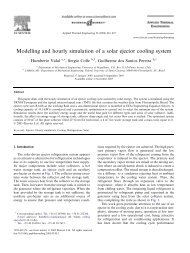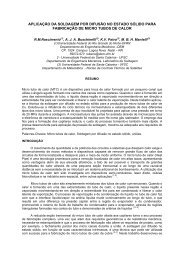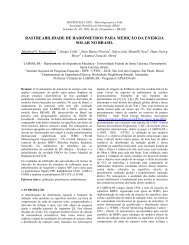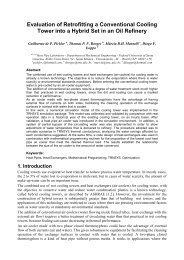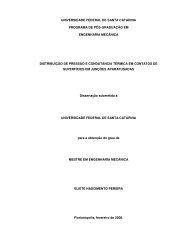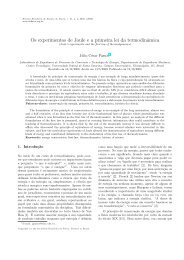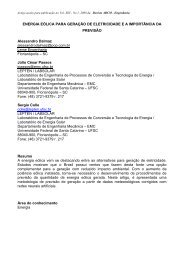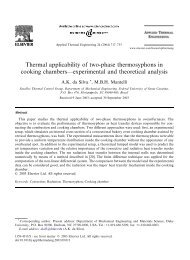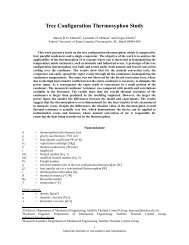analise dinâmica de um chiller de absorção de brometo de lítio ...
analise dinâmica de um chiller de absorção de brometo de lítio ...
analise dinâmica de um chiller de absorção de brometo de lítio ...
- No tags were found...
You also want an ePaper? Increase the reach of your titles
YUMPU automatically turns print PDFs into web optimized ePapers that Google loves.
10173.60 kg m −3 against a value of 73.41 kg m −3 obtainedin the industrial fermentation un<strong>de</strong>r analysis, representinga difference of 0.3%, and an ethanol fermentationefficiency of 88.4%.Consi<strong>de</strong>ring8hof process (fermentationtime plus wait time), the ethanol productivity is7.9kgm −3 h −1 . As seen from the figure, the fermentationtemperature reaches a maxim<strong>um</strong> of around 36 ◦ C.Thus, the use of water from the cooling tower as theonly cooling source is insufficient to keep the fermentationtemperature at the i<strong>de</strong>al value (32 ◦ C), which leadsto a lower efficiency.Figure 2. Ethanol E, substrate S and cell X concentrationprofiles for a fed-batch ethanol fermentation process usingonly the cooling tower to chill the vat.For the absorption <strong>chiller</strong> and cooling tower configuration,the mass flow rate of the absorption <strong>chiller</strong> (point18) is used to chill two fermentation vats and only halfof the mass flow rate from the cooling tower is used,because some of this stream is used in the absorption<strong>chiller</strong>. As seen from Figure 3, the fermentation temperature<strong>de</strong>creases by around 1 ◦ C with the absorption<strong>chiller</strong>/cooling tower and the final ethanol concentrationis 74.17 kg m −3 , increasing the ethanol concentration byaround 0.57 kg m −3 , which represents an annual ethanolincrease of approx. 240 m 3 per fermentation vat. Thefermentation efficiency of process is 89.2%and ethanolproductivity is 8.0kgm −3 h −1 ,consi<strong>de</strong>ring8hof fermentation.Figure 3. Fermentation temperature profiles T 21 using thecooling tower and the absorption <strong>chiller</strong>/cooling tower.With the cooling system shown in Figure 1, the coolingcapacity of the absorption <strong>chiller</strong> is not sufficientto remove all the heat released during the fermentation.The fermentation temperature T 21 continues tovary and differs greatly from the i<strong>de</strong>al temperature(32 ◦ C). A simulation with the fermentation temperaturekept constant at 32 ◦ C during the whole process wasperformed, and the final ethanol concentration reached75.37 kg m −3 , representing an annual ethanol increase ofaround 770 m 3 per fermentation vat. In this case, thefermentation efficiency and the ethanol productivity are90.9% and 8.1kgm −3 h −1 , respectively. The fermentationefficiency increased 2.5% in comparison with thatof the refrigeration system with only the cooling tower.Thus, keeping the temperature at the i<strong>de</strong>al value canreadily give several improvements in the process in termsof fermentation efficiency, productivity and cell viability.At high temperatures, the specific growth rate of contaminantmicroorganisms is increased, thus increasingthe <strong>de</strong>gree of contamination in the process. This contaminationcauses flocculation of the yeast cells, leadingto problems in the centrifugation and incurring highcosts for antibiotics. The high ethanol concentrationcombined with the high temperatures submits the cellsto stress conditions. Un<strong>de</strong>r these conditions the yeasthas a higher ten<strong>de</strong>ncy to produce glycerol, which is themain by-product of ethanol fermentation. Thus, lowertemperatures reduce the glycerol production, increasingthe process efficiency.Working with a lower fermentation temperature, theinlet substrate concentration S in of the vat can be increasedwithout adversely affect the fermentation process.Thus, on increasing the inlet substrate concentration,the production of ethanol in the fermentation vatincreases and a wine with a higher ethanol concentrationis passed to the distillery, producing a smaller amountof vinasse and requiring a lower thermal load (Camargoet al. 1990). The optimization of the fermentation processto increase the ethanol productivity, maintain cellviability and <strong>de</strong>crease the fermentation time, is nee<strong>de</strong>dwhen a higher inlet substrate concentration is used.The heat flow released during the fermentation ˙Q fand the heat flow of the fermentation heat exchanger˙Q fhx with the absorption <strong>chiller</strong>/cooling tower are shownin Figure 4. As seen from the figure, the heat flow offermentation is greater than the heat flow of the heatexchanger, thus the fermentation temperature increasesduring the process. The i<strong>de</strong>al process would be whenthe heat flow released and the heat flow of the heat exchangerare the same. This can be achieved by controllingthe fermentation temperature using the chilledwater flow valve as the manipulated variable or usingcold water with a high mass flow rate to maintain thei<strong>de</strong>al temperature.Pressures profile of the absorption <strong>chiller</strong> internalflows is presented in Figure 5. High and low pressuresincrease slightly because of the temperature variation ofcooling tower outlet, thereby internal temperatures arealso affected, as shown in Figure 6. Chiller’s COP variationsduring the fermentation process are negligible,holding close to 0.81.The lithi<strong>um</strong> bromi<strong>de</strong> concentrations of the weak solutionξ 3 and the strong solution ξ 4 are shown in Figure7. The concentrations and the concentration differ-Int. J. of Thermodynamics (IJoT) Vol. 13 (No. 3) / 115



